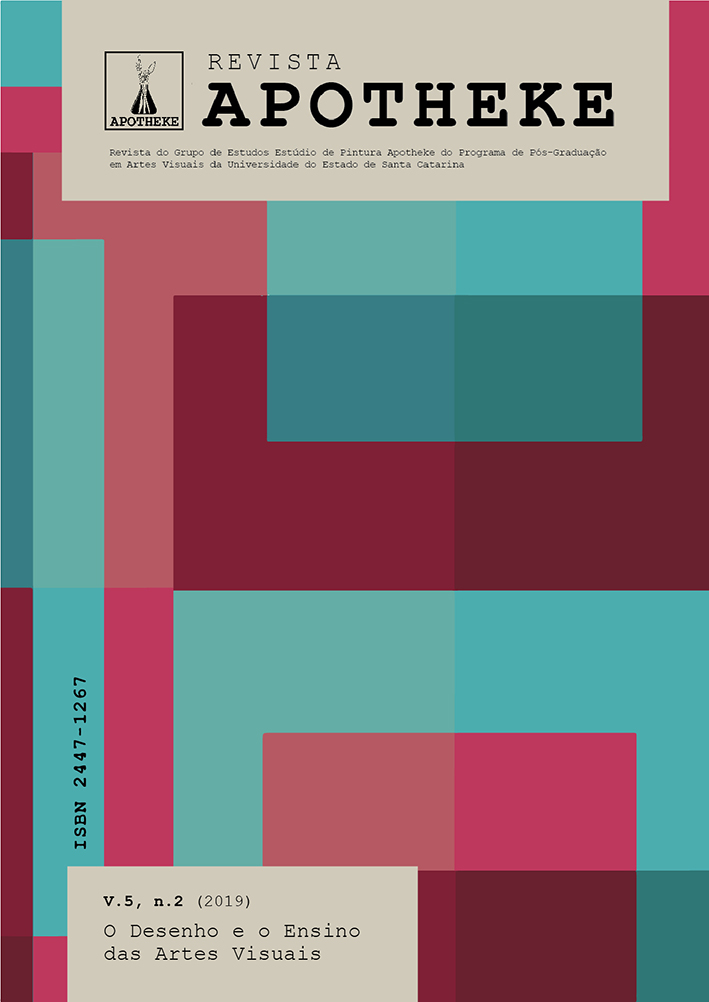Desenho e linha: modos de Pensamento e Expressão
DOI:
https://doi.org/10.5965/24471267522019101Keywords:
line, drawing, extension of trought, expressionAbstract
This paper addresses some considerations about the content approached in the second chapter of my thesis, which extends to the questions of the line in its generais scope and in the specific one of the drawing. The study involves the theme of drawing as being a direct means of expression and the presence of the line acting in the ordering of our abstract thinking. It is questioned to what extent the proximity with the drawing in the day to day, by its character of annotation or orientation, could activate its practice as a means of creation in the arts. I conclude by presenting three contemporary artists who work on the problematic of the line in the expanded field of drawing.
Downloads
References
BENJAMIN, Walter. Sobre a Pintura ou Sinal e Mancha. in: MOLDER, Filomena. Matérias Sensíveis. Lisboa: Relógio D' Agua Editores, 1999.
BUTLER, Connie e DE ZEGHER, Catherine. On line: Drawing trough the Twentieth Century. Publicado por The Museum of Modern Art, Nova York, 2010.
BROOKS, Alfred. Drawing. in The Art Bulletin vol. 2, n.3. New York: College Art Association, março de 1920).
CATTANI, Icleia. O desenho como abismo. in Revista Porto Arte v 13, nº 23 – Porto Alegre, 2005. Universidade Federal do Rio Grande do Sul. Instituto de Artes.
DUZZO, Flávia. Ausências no desenho: áreas de não desenho, apagamento e desgaste. Tese de Doutorado. Universidade Federal do Rio Grande do Sul – Instituto de Artes – Programa de Pós-graduação em Artes Visuais, Porto Alegre, Brasil. 2014.
GODOY, Vinícius. Iberê. Influência é desenho. Tese de Doutorado. Universidade Federal do Rio Grande do Sul – Instituto de Artes – Programa de Pós-graduação em Artes Visuais, Porto Alegre, Brasil. 2009.https://lume.ufrgs.br/handle/10183/2/browse?type=author&value=Godoy%2C+Vin%C3%ADcius+Oliveira. Consulta: 05/07/2019
HOUAISS, Antônio. Dicionário Houaiss da Língua Portuguesa. Rio de Janeiro, Ed. Objetiva, 2009.
MOLINA, Juan José Gómez. Las lecciones Del dibujo. Ediciones Cátreda. Madrid-Espanha, 2006.
PAREYSON, Luigi. Teoria da Formatividade. Rio de Janeiro:Vozes,1993.
TONE, Lilian(org.) William Kentridge Fortuna. Catálogo da exposição, 2012.
VINCI, Leonardo da. The Notebooks of Leonardo Da Vinci.
Downloads
Published
How to Cite
Issue
Section
License
Copyright (c) 2019 REVISTA APOTHEKE

This work is licensed under a Creative Commons Attribution-NonCommercial 4.0 International License.
Copyright and Licensing Policy
Authors of works submitted to Revista APOTHEKE authorize their publication in both print and digital formats exclusively for academic purposes. Reproduction is permitted, provided that the source is properly cited. Authors confirm the originality, authorship, and unpublished status of their manuscripts.
Articles published by the journal are freely available and intended for academic and non-commercial use only. All copyrights are transferred to the journal. The content of signed articles reflects the views of their respective authors and not the official position of Revista Apotheke. The author(s) agree to always cite the following reference when republishing or referring to the content originally published in Revista Apotheke:
“This article was originally published by Revista Apotheke in volume (insert volume), number (insert number), year (insert year), and is available at: http://www.revistas.udesc.br/index.php/APOTHEKE/index”
It is the sole responsibility of the authors to obtain written permission for the use of any material protected by copyright law included in their articles. Revista Apotheke is not responsible for copyright infringements committed by contributors.
Authors retain copyright and grant the journal the right of first publication, with the work licensed under a Creative Commons Attribution-NonCommercial License (CC BY-NC):
-
Attribution (BY): Licensees are allowed to copy, distribute, display, perform, and create derivative works, provided that proper credit is given to the author or licensor, in the manner specified.
-
NonCommercial (NC): Licensees may use the material only for non-commercial purposes.
After publication, authors retain the rights to their work and may republish the text.



